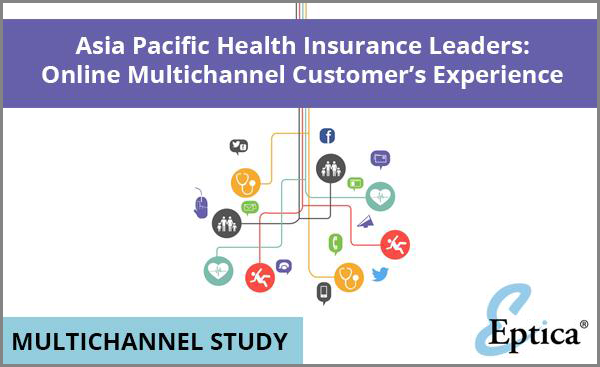Are APAC health insurers delivering multichannel service to customers?

Health insurance is a rapidly growing market across Asia Pacific. The rise of a more affluent middle class and gaps in public healthcare mean that more and more people are now looking to private health insurers to provide for their needs.
How consumers research and buy insurance policies, and then interact with insurers, is also changing fast, moving to a digital and multichannel world. Today, insurance buyers want the ability to contact health insurers through their channel of choice, such as the web, email, chat or social media, rather than be forced to pick up the phone. Delivering the right experience will therefore be critical for insurers looking to benefit from the growth in the market.
So how are APAC health insurers responding to this challenge? To find out, Eptica carried out an extensive research study with top health insurance brands in the region. The 2015 Eptica APAC Health Insurance Multichannel Customer Experience Study analyzed the performance of 10 leading insurers on the web, email, chat and social media channels. Researchers tried to find answers to commonly asked questions on each company’s website, and also asked a single question via each of the email, Twitter, Facebook and chat channels. The aim was to mimic consumer behavior to provide a true reflection of the state of customer experience in the sector.
There were five key findings from the research:
1. Insurers are not yet multichannel
Individual insurers seem to be focusing on specific channels, rather than providing customers with a choice. For example, companies that ranked top for answering questions on their websites came bottom for responding successfully to email. Additionally, there is not a wide choice of channels outside the web and email – only 10% of companies offered chat, and while all companies had Twitter and Facebook accounts, response rates on these channels was very low. Despite 100% of companies being on Facebook, none could successfully answer a question through the channel.
2. Stretched resources
The move to digital channels not only increases the number of ways for consumers to contact a company, but also leads to a rise in the overall volume of contacts. Consumers are more demanding and want more information, faster, meaning that they are more likely to ask questions across every channel. The Eptica study found that resources are consequently being stretched, with just over half (53%) of emails, tweets and Facebook messages left unanswered. The one company that offered chat did not have it working when evaluated – showing that resources had been deployed elsewhere. As consumers ask more and more questions through digital channels they expect faster and more informed responses – clearly resources need to be increased if health insurers are to meet their needs.
3. The growth of mono-channel
Very few companies were able to provide consistent answers across multiple channels. Half (50%) only answered on a single channel out of chat, email, Facebook and Twitter, while 10% didn’t provide a response on any of these channels. Delivering a joined-up service, that is consistent across multiple channels, is one of the key requirements for consumers, yet currently many insurers are failing to provide this. It also hurts efficiency – if a customer doesn’t receive an answer on one channel and is forced to switch to another, such as the telephone, costs will rise unnecessarily.
4. Responses are not answering the question
Insurers were marked on a number of simple criteria – did they respond to the query, and did they successfully answer the question that was asked? As mentioned above just 47% of questions received a response – but 80% of these either didn’t provide a useful answer or would have required the consumer to follow up, wasting their time and resources. Essentially that means just 9% of all emails, tweets, Facebook messages and web queries were answered successfully. Those health insurers that can improve performance fastest will therefore be likely to win business at the expense of their rivals.
5. Consistency is lacking
Even those insurers that claim to offer service across multiple channels are not joining them up, and are providing different answers on each channel. Just 30% of customers provided consistent answers across two or more channels. This not only confuses consumers but can lead to wider issues that potentially cost the company money. For example, if consumers on one channel are offered discounts which are not available on others, it can cause complaints and potentially damage brand reputation. This failure to integrate channels leads to inefficient, silo-based working, making it difficult to add new channels, launch new products or deliver a holistic customer experience.
The findings in the 2015 Eptica APAC Health Insurance Multichannel Customer Experience Study show that health insurers are beginning to move to a more digital, integrated approach to customer experience. However, there is still a long way to go, with many still very focused on the telephone channel, rather than providing true, multichannel service.
To read more about the findings, along with recommendations on how insurers can change to meet this challenge, Eptica has created a full management report on the Study. Available here, it includes a full methodology and channel by channel results.







Comments